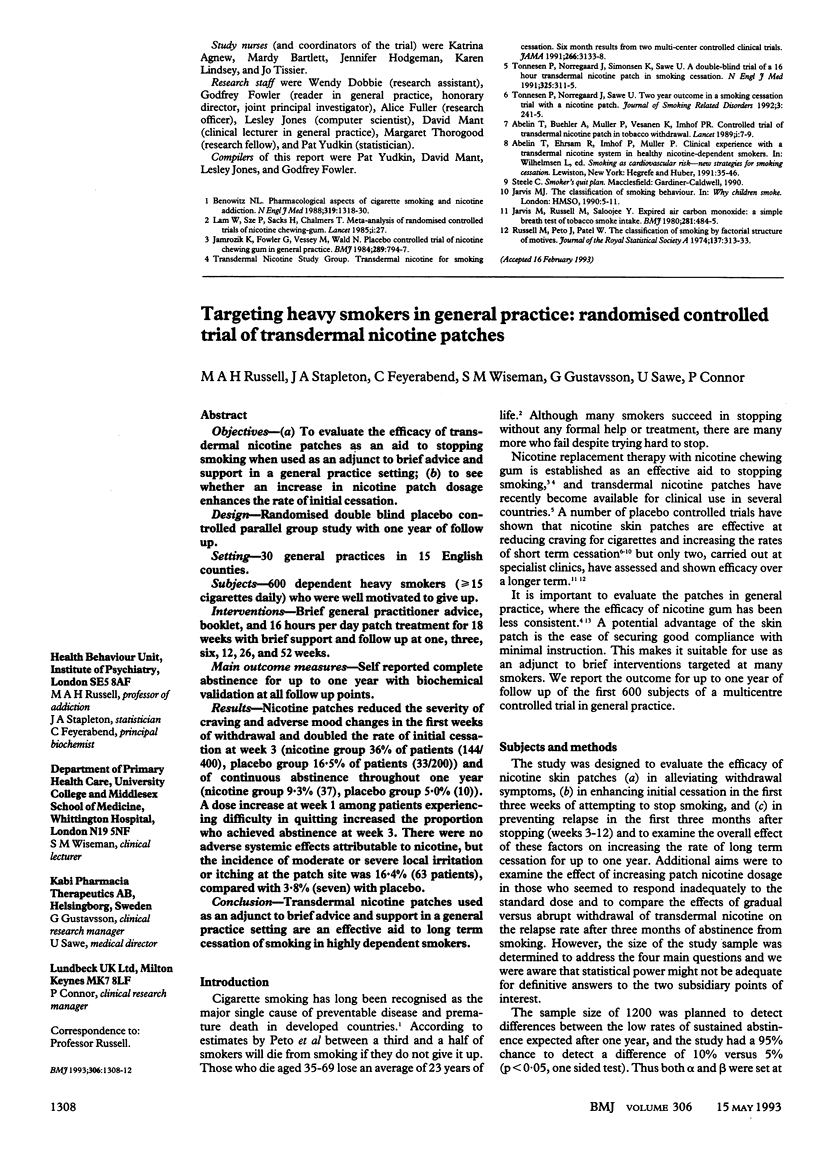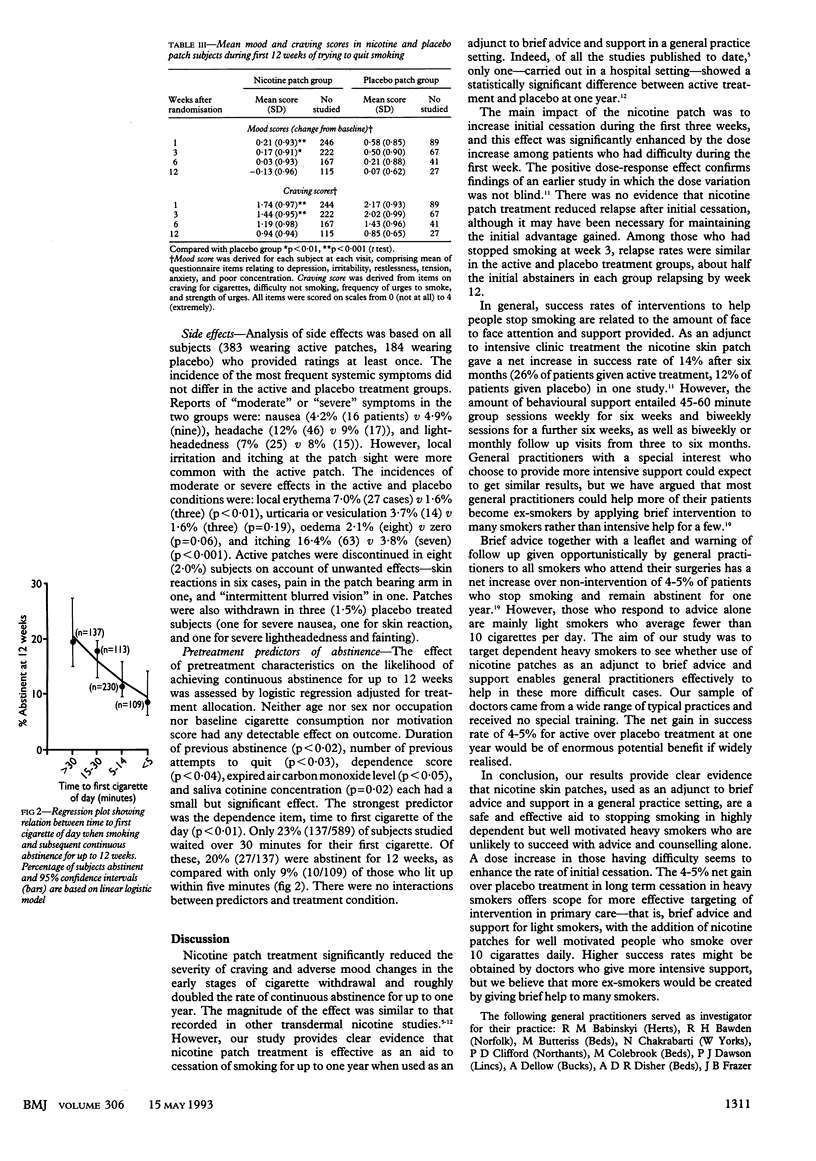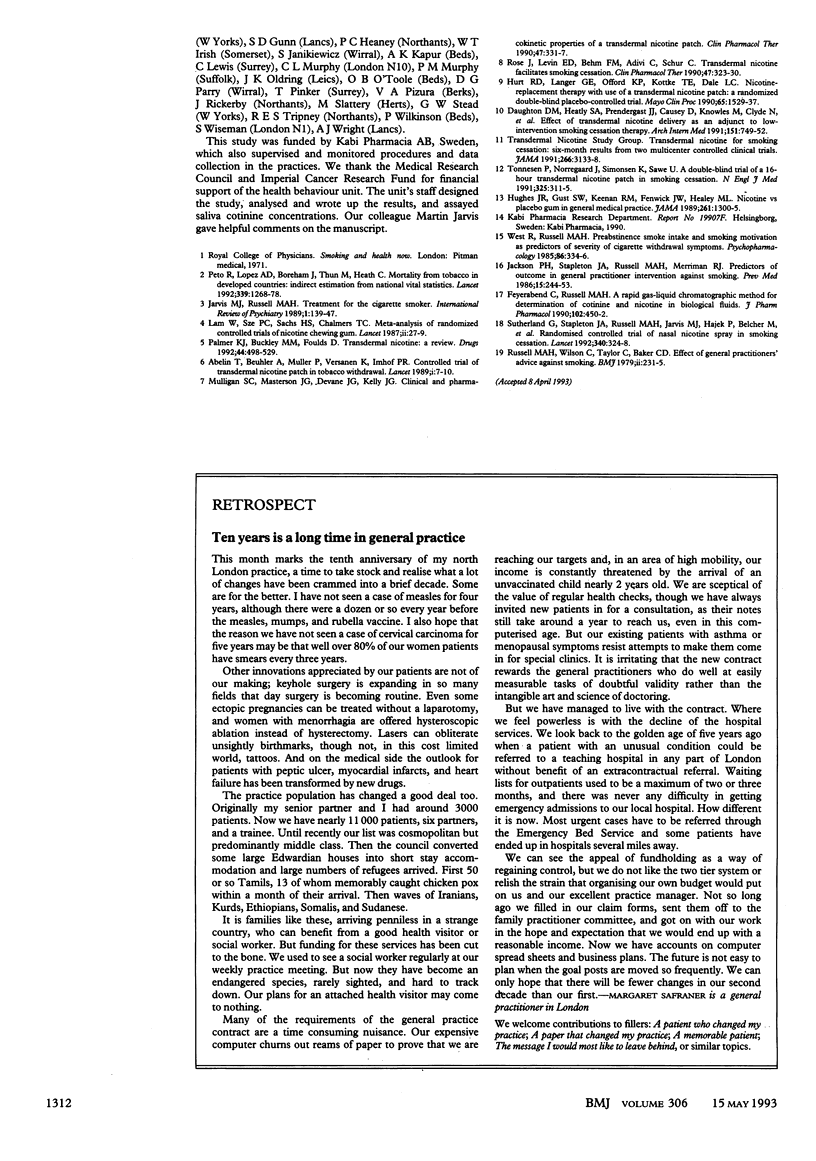Abstract
OBJECTIVES--(a) To evaluate the efficacy of transdermal nicotine patches as an aid to stopping smoking when used as an adjunct to brief advice and support in a general practice setting; (b) to see whether an increase in nicotine patch dosage enhances the rate of initial cessation. DESIGN--Randomised double blind placebo controlled parallel group study with one year of follow up. SETTING--30 general practices in 15 English counties. SUBJECTS--600 dependent heavy smokers (> or = 15 cigarettes daily) who were well motivated to give up. INTERVENTIONS--Brief general practitioner advice, booklet, and 16 hours per day patch treatment for 18 weeks with brief support and follow up at one, three, six, 12, 26, and 52 weeks. MAIN OUTCOME MEASURES--Self reported complete abstinence for up to one year with biochemical validation at all follow up points. RESULTS--Nicotine patches reduced the severity of craving and adverse mood changes in the first weeks of withdrawal and doubled the rate of initial cessation at week 3 (nicotine group 36% of patients (144/400), placebo group 16.5% of patients (33/200)) and of continuous abstinence throughout one year (nicotine group 9.3% (37), placebo group 5.0% (10)). A dose increase at week 1 among patients experiencing difficulty in quitting increased the proportion who achieved abstinence at week 3. There were no adverse systemic effects attributable to nicotine, but the incidence of moderate or severe local irritation or itching at the patch site was 16.4% (63 patients), compared with 3.8% (seven) with placebo. CONCLUSION--Transdermal nicotine patches used as an adjunct to brief advice and support in a general practice setting are an effective aid to long term cessation of smoking in highly dependent smokers.
Full text
PDF




Selected References
These references are in PubMed. This may not be the complete list of references from this article.
- Abelin T., Buehler A., Müller P., Vesanen K., Imhof P. R. Controlled trial of transdermal nicotine patch in tobacco withdrawal. Lancet. 1989 Jan 7;1(8628):7–10. doi: 10.1016/s0140-6736(89)91671-1. [DOI] [PubMed] [Google Scholar]
- Daughton D. M., Heatley S. A., Prendergast J. J., Causey D., Knowles M., Rolf C. N., Cheney R. A., Hatlelid K., Thompson A. B., Rennard S. I. Effect of transdermal nicotine delivery as an adjunct to low-intervention smoking cessation therapy. A randomized, placebo-controlled, double-blind study. Arch Intern Med. 1991 Apr;151(4):749–752. [PubMed] [Google Scholar]
- Feyerabend C., Russell M. A. A rapid gas-liquid chromatographic method for the determination of cotinine and nicotine in biological fluids. J Pharm Pharmacol. 1990 Jun;42(6):450–452. doi: 10.1111/j.2042-7158.1990.tb06592.x. [DOI] [PubMed] [Google Scholar]
- Hughes J. R., Gust S. W., Keenan R. M., Fenwick J. W., Healey M. L. Nicotine vs placebo gum in general medical practice. JAMA. 1989 Mar 3;261(9):1300–1305. [PubMed] [Google Scholar]
- Hurt R. D., Lauger G. G., Offord K. P., Kottke T. E., Dale L. C. Nicotine-replacement therapy with use of a transdermal nicotine patch--a randomized double-blind placebo-controlled trial. Mayo Clin Proc. 1990 Dec;65(12):1529–1537. doi: 10.1016/s0025-6196(12)62186-7. [DOI] [PubMed] [Google Scholar]
- Jackson P. H., Stapleton J. A., Russell M. A., Merriman R. J. Predictors of outcome in a general practitioner intervention against smoking. Prev Med. 1986 May;15(3):244–253. doi: 10.1016/0091-7435(86)90044-7. [DOI] [PubMed] [Google Scholar]
- Lam W., Sze P. C., Sacks H. S., Chalmers T. C. Meta-analysis of randomised controlled trials of nicotine chewing-gum. Lancet. 1987 Jul 4;2(8549):27–30. doi: 10.1016/s0140-6736(87)93061-3. [DOI] [PubMed] [Google Scholar]
- Mulligan S. C., Masterson J. G., Devane J. G., Kelly J. G. Clinical and pharmacokinetic properties of a transdermal nicotine patch. Clin Pharmacol Ther. 1990 Mar;47(3):331–337. doi: 10.1038/clpt.1990.36. [DOI] [PubMed] [Google Scholar]
- Palmer K. J., Buckley M. M., Faulds D. Transdermal Nicotine. A review of its pharmacodynamic and pharmacokinetic properties, and therapeutic efficacy as an aid to smoking cessation. Drugs. 1992 Sep;44(3):498–529. doi: 10.2165/00003495-199244030-00011. [DOI] [PubMed] [Google Scholar]
- Peto R., Lopez A. D., Boreham J., Thun M., Heath C., Jr Mortality from tobacco in developed countries: indirect estimation from national vital statistics. Lancet. 1992 May 23;339(8804):1268–1278. doi: 10.1016/0140-6736(92)91600-d. [DOI] [PubMed] [Google Scholar]
- Rose J. E., Levin E. D., Behm F. M., Adivi C., Schur C. Transdermal nicotine facilitates smoking cessation. Clin Pharmacol Ther. 1990 Mar;47(3):323–330. doi: 10.1038/clpt.1990.35. [DOI] [PubMed] [Google Scholar]
- Russell M. A., Wilson C., Taylor C., Baker C. D. Effect of general practitioners' advice against smoking. Br Med J. 1979 Jul 28;2(6184):231–235. doi: 10.1136/bmj.2.6184.231. [DOI] [PMC free article] [PubMed] [Google Scholar]
- Sutherland G., Stapleton J. A., Russell M. A., Jarvis M. J., Hajek P., Belcher M., Feyerabend C. Randomised controlled trial of nasal nicotine spray in smoking cessation. Lancet. 1992 Aug 8;340(8815):324–329. doi: 10.1016/0140-6736(92)91403-u. [DOI] [PubMed] [Google Scholar]
- West R. J., Russell M. A. Pre-abstinence smoke intake and smoking motivation as predictors of severity of cigarette withdrawal symptoms. Psychopharmacology (Berl) 1985;87(3):334–336. doi: 10.1007/BF00432717. [DOI] [PubMed] [Google Scholar]


